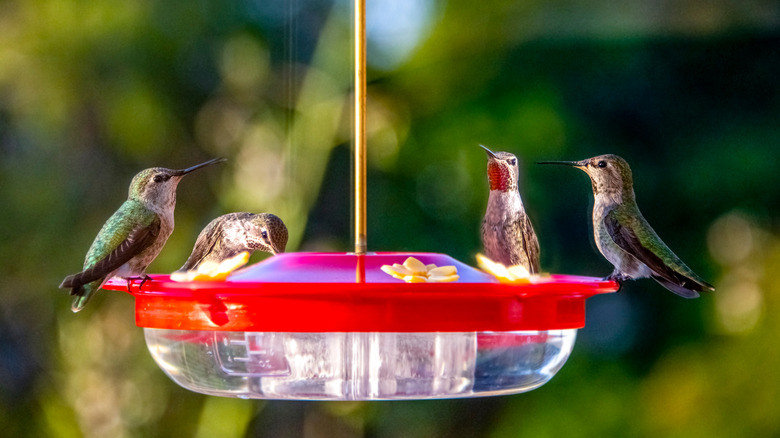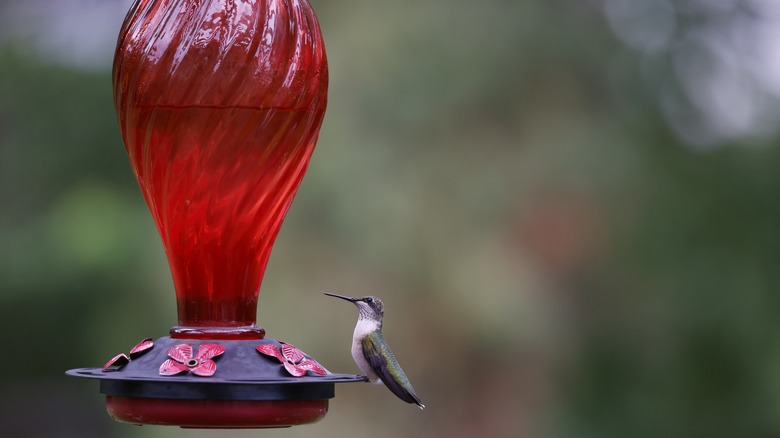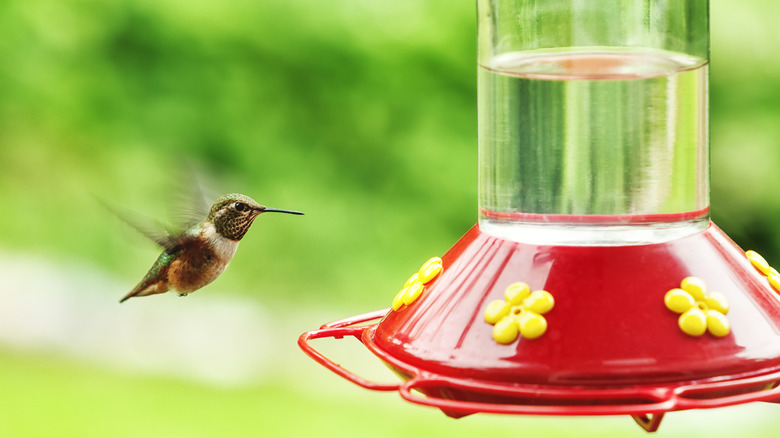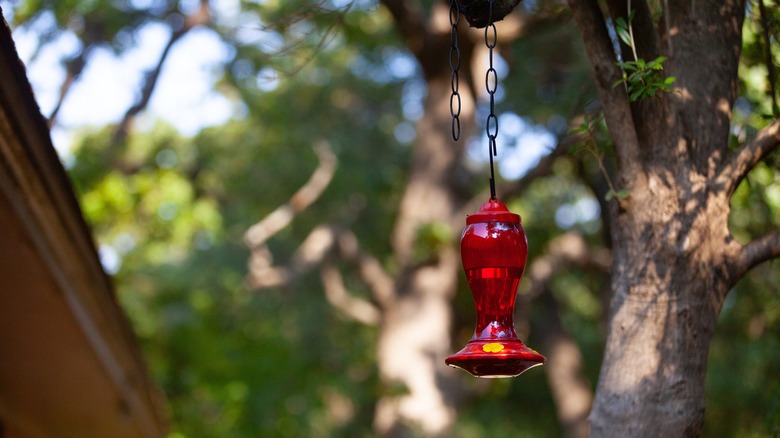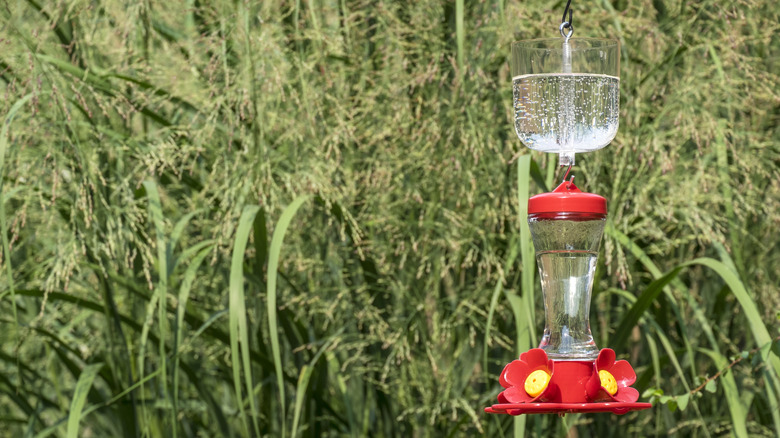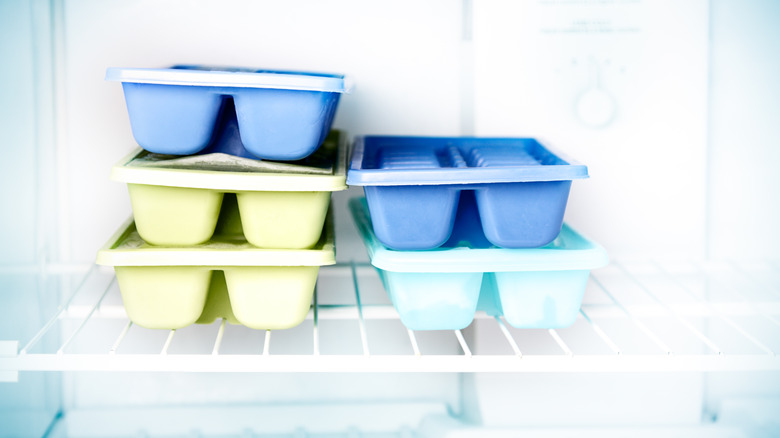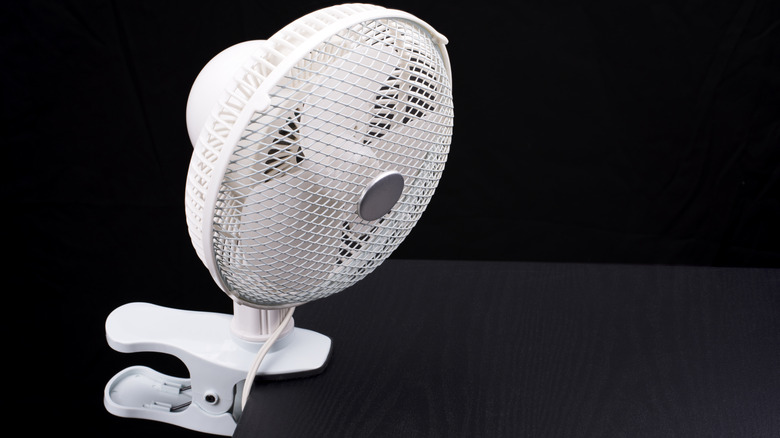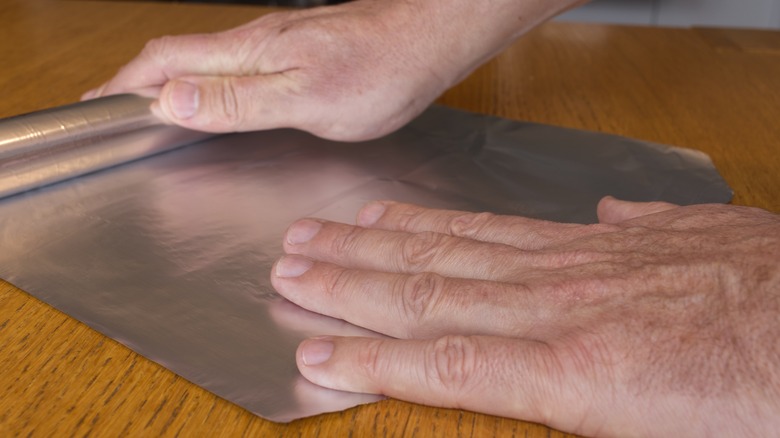8 Ways To Keep Your Hummingbird Feeder Cool In Hot Weather
Hummingbirds are stunning creatures, not only because of the variety of colored feathers they sport, but also because they have the ability to hover around flowers and feeders. Many nature lovers entice hummingbirds to visit their backyards by setting up a few of these feeders and filling them with a delicious nectar. A problem arises, however, once temperatures begin to soar above 100 degrees Fahrenheit. High heat causes hummingbird nectar to grow bacteria, which can seriously harm the mesmerizing animals.
In order to prevent hummingbirds from getting sick after drinking nectar infected with aspergillosis or salmonellosis, homeowners must take steps to cool the feeders on hot days. A few ways to eliminate the conditions needed for harmful bacteria to thrive include swapping out a plastic feeder for a glass model, adding frozen nectar to the feeder, and installing a battery-powered fan to keep the nectar cool. Following these tips is the best way to keep hummingbirds healthy and to ensure they return to your garden again and again.
Switch to a glass or ceramic feeder
While plastic hummingbird feeders tend to be the most affordable option, they aren't a good choice in areas that experience extreme temperatures in the summer. Not only do plastic feeders retain heat, but they are also more prone to bacterial growth. To keep your hummingbird nectar cooler during the summer months, you'll need to switch out your plastic feeders for glass or ceramic feeders.
When choosing a glass or ceramic feeder size is important. If you have a charm of hummingbirds looking for some sweet nectar, you'll want to go with a 32-ounce feeder versus a smaller 10-ounce feeder that would serve just a few birds. PennState Extension also suggests selecting a feeder that has the color red on it somewhere, as hummingbirds are attracted to this hue. Even though glass and ceramic hummingbird feeders are less prone to bacteria growth, you'll still need to clean them regularly to provide visiting birds with a healthy meal. To clean the feeders, you'll need to use either soap and water or a little vinegar and water. No matter which option you select, it is essential that you completely rinse away all of the soap or vinegar residue.
Change out warm nectar for cool
On hot days, it becomes necessary to change out the hot nectar for cool nectar. While some nature enthusiasts report that nectar should be replaced every one to two days when temperatures reach above 80 degrees Fahrenheit, Birds & Blooms experts advise nectar be discarded and refilled two to three times per day when temperatures reach and exceed 90 degrees Fahrenheit. You don't want to chance waiting until the sugar goes bad, as hummingbirds that drink spoiled nectar can become quite sick.
In addition to planning out times to replace the warm nectar with cool, you'll want to keep an eye on the sweet water for signs that it is going bad. Cloudy water is one such sign, as this indicates the growth of bacteria. Mold growth will be visible to the eye, as will any crystals that form due to the sugar going stale. Another thing to watch for is dead insects. If the insects have passed away after drinking the nectar, chances are it has spoiled.
Choose a location that offers sun protection
Another way to keep your hummingbird feeder cool in hot weather is to utilize a space that offers protection from the sun's scorching rays. Setting the hummingbird feeder in a location that receives shade will keep the sun from beating on the nectar. Less direct sun means the nectar won't get as hot. Both natural and artificial shade will work, so if you don't have any tall trees, you can still provide your feeder with some cover.
Look for an area in your yard that features protection from the sun. A tree with plenty of leaves will work, as will a covered porch. If your property doesn't offer these options, you'll need to create a shady environment. You may need to think outside of the box. One homeowner did just that by setting up an umbrella to provide shade for her hummingbird feeder. Another option is to erect a hat above the feeder or install a small canopy using an old cloth. If you need to you can always move the feeder out of a sunny area during the hottest parts of the day and then put it back when the sun begins to set.
Attach an ant moat to the feeder
When it comes to accessories, you'll find adding an ant moat to your hummingbird feeder will help keep the nectar a bit cooler. This is because ant moats use water to keep insects from reaching and consuming the hummingbird's nectar. The water within the ant moat also provides a cooling effect to keep nectar temperatures from rising as quickly as they would if you just used the feeder by itself.
There are hummingbird feeders on the market that include a built-in ant moat, which is a good option if your current feeder is in need of replacement. There's no need to swap out your feeder, however, if it's in good shape. You can simply purchase an ant moat protector and attach it to your existing feeder. The ant moat comes with an S-hook at the bottom, which is where you will attach the feeder. The upper hook can then be used to hang the entire unit from a tree branch or porch hook.
Create your own nectar ice cubes
While swapping out warm nectar for cool is a good strategy for keeping your hummingbird feeder from becoming too hot, using nectar ice cubes will provide a longer lasting solution. On hot days, you'll want to start out by placing homemade nectar ice cubes in your feeder. As the temperatures climb, the nectar ice cubes will melt, providing a continuous cool drink for several hours. Utilizing this method will also result in having to replace the nectar less often.
To create your homemade nectar ice cubes, you'll first need to prepare the nectar. Place ¼ cup of white granulated sugar for every 1 cup of water in a pot. Bring the water to a boil and then remove the pot from the heat. Stir to combine the two ingredients and then wait for them to completely cool. Pour the hummingbird nectar into an ice cube tray. Transfer the tray to the freezer and wait for the ice cubes to set. Once frozen, pop out the ice cubes and set them inside your feeder.
Tip: Another option is to freeze a tiny container of water and place it inside the feeder before filling the feeder with nectar. This will keep the nectar cool without diluting it. Never place regular ice cubes directly in the feeder, as they will dilute the nectar when they melt.
Include a layer of insulation
Insulation not only keeps warm things warm, but it also helps colder items stay cold. You can utilize this concept as a way to keep your hummingbird nectar from becoming too hot when temperatures begin to rise. You need only take a few minutes to provide a layer of insulation around your feeders to reap the benefits.
Choose your insulation. There are a few options that can easily be adapted to work for your hummingbird feeder. The first is a drink cozy. If your feeder is on the slim side, all you need to do is grab a pair of scissors and cut out the bottom of the cozy. You can now slip the cozy over the body of the feeder. Another option is to purchase a roll of foam wrap and cut it to fit around the feeder's body. A little tape is all you need to hold it in place. Finally, you can use insulation tape to wrap around your hummingbird nectar. This tape is often wrapped around pipes to provide added insulation during the cold winter months, but it can also be used around the body of your hummingbird feeder.
Install a small battery-powered fan
When you want to keep a room in your home cool during a heat wave, you most likely turn on a few fans. You can do the same for your hummingbird feeder, as the fans keep the air flowing around the feeder, which in turn helps prevent the nectar from becoming too hot for the birds to drink. A small battery-powered fan is ideal, as an electric fan may provide a risk of shock. It's also not a good idea to run an extension cord from your house out to the garden where your hummingbird feeder is located.
When choosing a fan for your hummingbird feeder, look for a model that sits above a clip. The clip makes the fan easy to install, as you can quickly attach it to your feeder by pinching the ends to open the mouth of the clip. When you release the ends, the clip firmly grasps the feeder. You'll also want to make sure the battery-powered fan has an adjustable head, so that you can point it at the nectar. A model with several speeds is preferred, as you can alter the speed as needed.
Wrap aluminum foil around the feeder
If you've ever seen people wrap aluminum foil around their hummingbird feeders and wondered why, you may be surprised to learn the answer. Aluminum foil actually has the ability to reflect light and heat, thanks to its shiny surface, as well as create a thermal barrier. Chances are you already have a roll of aluminum foil in your kitchen, but if not, a roll only costs around $1.50 at Walmart for 25 square feet.
Measure around the body of your hummingbird feeder and then cut out a sheet to match from your roll of aluminum foil. Wrap the sheet around the feeder. It may stay without any adhesive, but a little bit of tape is best to keep the foil in place on days that may be a bit windy. Replace the sheet when it becomes worn. Don't forget to keep up with regular cleanings to prevent the growth of harmful bacteria.
Tip: Combine this method for keeping your hummingbird feeder cool in hot weather with another one of the strategies mentioned above, such as filling the feeder with nectar ice cubes. Implementing the two tactics at the same time will further help keep the nectar at a safe temperature for your visiting birds.
